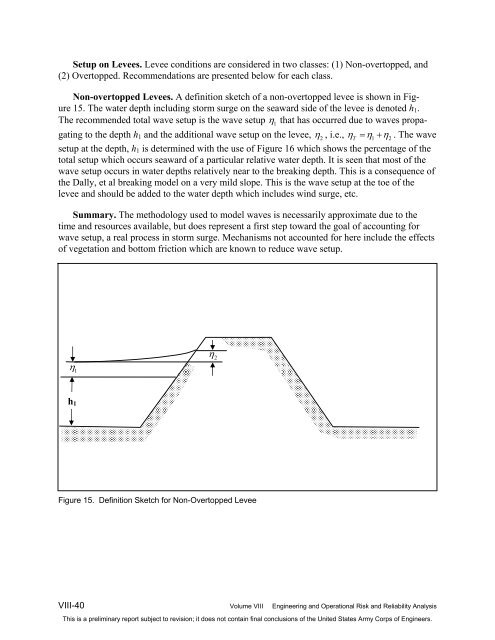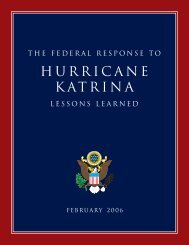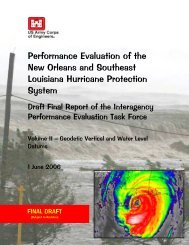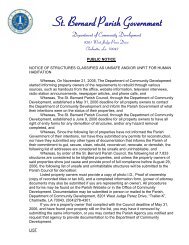IPET Report 3 Vol VIII
IPET Report 3 Vol VIII
IPET Report 3 Vol VIII
You also want an ePaper? Increase the reach of your titles
YUMPU automatically turns print PDFs into web optimized ePapers that Google loves.
Setup on Levees. Levee conditions are considered in two classes: (1) Non-overtopped, and<br />
(2) Overtopped. Recommendations are presented below for each class.<br />
Non-overtopped Levees. A definition sketch of a non-overtopped levee is shown in Fig-<br />
ure 15. The water depth including storm surge on the seaward side of the levee is denoted h1.<br />
The recommended total wave setup is the wave setup η 1 that has occurred due to waves propa-<br />
gating to the depth h1 and the additional wave setup on the levee, η 2 , i.e., ηT η1 η2<br />
= + . The wave<br />
setup at the depth, h1 is determined with the use of Figure 16 which shows the percentage of the<br />
total setup which occurs seaward of a particular relative water depth. It is seen that most of the<br />
wave setup occurs in water depths relatively near to the breaking depth. This is a consequence of<br />
the Dally, et al breaking model on a very mild slope. This is the wave setup at the toe of the<br />
levee and should be added to the water depth which includes wind surge, etc.<br />
Summary. The methodology used to model waves is necessarily approximate due to the<br />
time and resources available, but does represent a first step toward the goal of accounting for<br />
wave setup, a real process in storm surge. Mechanisms not accounted for here include the effects<br />
of vegetation and bottom friction which are known to reduce wave setup.<br />
η 1<br />
h1<br />
η<br />
2<br />
Figure 15. Definition Sketch for Non-Overtopped Levee<br />
<strong>VIII</strong>-40 <strong>Vol</strong>ume <strong>VIII</strong> Engineering and Operational Risk and Reliability Analysis<br />
This is a preliminary report subject to revision; it does not contain final conclusions of the United States Army Corps of Engineers.













